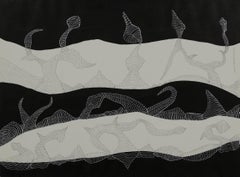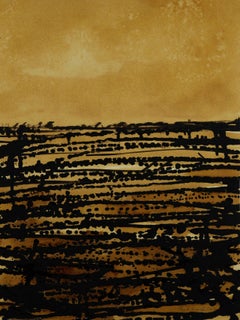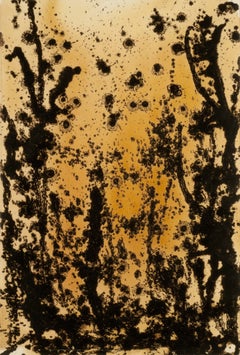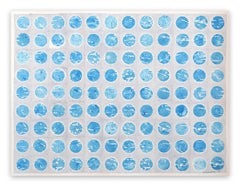Ray H. French Abstract Drawings and Watercolors
to
3
1
1
2
Overall Height
to
Overall Width
to
2
3
3
28
136
125
78
71
2
1
1
Artist: Ray H. French
Sea Forms
By Ray H. French
Located in Fairlawn, OH
Signed and dated center right edge; Annotated "48" lower left
Provenance:
Estate of the artist
One of a suite of 120 drawings that the artist did in 1 month.
Most were sold thro...
Category
1960s Abstract Ray H. French Abstract Drawings and Watercolors
Materials
Ink, Pen
Untitled
By Ray H. French
Located in Fairlawn, OH
Signed and dated "1962" by the artist lower right.
Mixed media on heavy paper.
Done for a show to fund a trip to Italy.
Category
1960s Abstract Ray H. French Abstract Drawings and Watercolors
Materials
Ink, Mixed Media
Untitled (Abstraction)
By Ray H. French
Located in Fairlawn, OH
Signed and dated by the artist vertically lower left edge.
Part of an experimental series of works using motor oil, India Ink, adhesives, sand, and various other mediums.
Category
1960s Ray H. French Abstract Drawings and Watercolors
Related Items
Abbe Morel, Untitled, composition in black, orange, green and plum
Located in PARIS, FR
Maurice MOREL said l’abbé Morel (1908-1991)
Untitled, composition in black, orange, green and plum
Mixed media on glossy paper (cut-out magazine page)
Signed on reverse
23 x 10 cm
So...
Category
Mid-20th Century Abstract Ray H. French Abstract Drawings and Watercolors
Materials
Watercolor, Gouache
Untitled 743 (Abstract Painting)
By Jérémie Iordanoff
Located in London, GB
Untitled 743 (Abstract Painting)
Watercolour on paper - Unframed.
Artwork exclusive to IdeelArt.
French abstract artist Jérémie Iordanoff blends the visual languages of Western Mo...
Category
2010s Abstract Ray H. French Abstract Drawings and Watercolors
Materials
Paper, Watercolor
Unique drawing Geometric Abstraction on postcard conceptual art (hand signed)
By Sol LeWitt
Located in New York, NY
Sol LeWitt
Unique Geometric Abstraction on Postcard, 1982
Original drawing done on postcard from the Van Gogh Museum (Amsterdam), mailed, stamped and postmarked (franked) from Spolet...
Category
1980s Abstract Geometric Ray H. French Abstract Drawings and Watercolors
Materials
Ink, Postcard, Mixed Media, Offset
Ammersee #2
By Walter Darby Bannard
Located in New York, NY
Walter Darby Bannard
Ammersee #2, 1975
Watercolor and acrylic painting on paper
Signed, titled and dated lower recto
This is a unique work
Frame included: elegantly floated and frame...
Category
1970s Abstract Expressionist Ray H. French Abstract Drawings and Watercolors
Materials
Ink, Mixed Media, Acrylic, Watercolor, Graphite
Things Previously Unknown #2 - Contemporary Abstract Painting (Grey+Yellow+Pink)
By Laurie Barmore
Located in Gilroy, CA
"Things Previously Unknown #2" is a contemporary abstract expressionist painting by Laurie Barmore. Her works are extremely dynamic, with impressionist-like strokes. This piece wil...
Category
2010s Contemporary Ray H. French Abstract Drawings and Watercolors
Materials
Acrylic, Paper
"Symbiotic String III" Paint on paper nature soft shapes neutral curves contrast
By Amanda Andersen
Located in Hamburg, HH
“Symbiotic Strings” is a series of three small studies of acrylic on paper created in 2024 by Amanda Andersen.
Minimal forms grow into each other with a simplicity and serenity simi...
Category
2010s Contemporary Ray H. French Abstract Drawings and Watercolors
Materials
Paper, Acrylic, Graphite
H 10.24 in W 14.18 in D 0.04 in
Italian Abstract Work on Paper Color Field Non-Objective European Mid-Century
By Piero Dorazio
Located in New York, NY
Italian Modern Abstract Work on Paper Color Field Non-Objective European Mid-Century - "Gonage"
Dorazio completed "Gonage" in 1949 when just after the artist had been awarded a stipend by the French government and admission to the Academy Beaux Arts. There he met George Braque who became great friends but also an influence on Dorazio, of which "Gonage" is a living testament.
"Gonage" actual size of the drawing measures 12 x 9 1/2 inches. It is signed on the lower right. The work is affixed to a 19 x 15 inch board which includes the artist's signature and date. There is a torn table on the lower left entitling the piece "Gonage".
Provenance follows this piece as a gift in 1950 to the artist-colleague Luigi Lucioni, who then gifted it in 1955 to his friend, the uncle of the current owner who has owned the work since 1988.
Bio
Born in Italy, Piero Dorazio studied architecture in Rome. At the same time his first abstract works were executed. In 1947 he received a scholarship from the Ecole Nationale Supérieure des Beaux Arts in Paris, where he contacted Modern artists, who lived in Paris. He founded the galleries "Age d'Or" in Florence and Rome to represent avant-garde arts in Italy.
During a one year stay in the USA he got acquainted with leading artists of Abstract Expressionism such as Marc Rothko...
Category
1940s Abstract Ray H. French Abstract Drawings and Watercolors
Materials
Gouache, Board
Pions (Abstract work on paper)
By Jérémie Iordanoff
Located in London, GB
Watercolour on paper - Unframed.
Artwork exclusive to IdeelArt.
French abstract artist Jérémie Iordanoff blends the visual languages of Western Modernist Abstraction with earlier, ...
Category
Early 2000s Abstract Ray H. French Abstract Drawings and Watercolors
Materials
Paper, Watercolor
Untitled 7 (Abstract painting)
By Jesús Perea
Located in London, GB
Untitled 7 (Abstract painting)
Ink and perforantions on indian paper — Unframed.
Fluctuating between illustration and expressionism, connecting the geometric and biomorphic worlds, ...
Category
2010s Abstract Ray H. French Abstract Drawings and Watercolors
Materials
Paper, Ink
1950s Abstract Composition in Brown, Orange and Blue with Black Parallel Lines
By Herbert Bayer
Located in Denver, CO
Watercolor and ink on paper of an abstract composition of brown, orange and blue shapes between black parallel lines throughout the the piece by Herbert Bayer (1900-1985). Presented in a custom black frame with all archival materials. Framed dimensions measure 17 ⅞ x 22 ⅝ x 1 inches. Image size is 10 ¼ x 15 ½ inches.
Painting is clean and in very good condition - please contact us for a detailed condition report.
Expedited and international shipping is available - please contact us for a quote.
About the Artist:
Herbert Bayer enjoyed a versatile sixty-year career spanning Europe and America that included abstract and surrealist painting, sculpture, environmental art, industrial design, architecture, murals, graphic design, lithography, photography and tapestry. He was one of the few “total artists” of the twentieth century, producing works that “expressed the needs of an industrial age as well as mirroring the advanced tendencies of the avant-garde.”
One of four children of a tax revenue officer growing up in a village in the Austrian Salzkammergut Lake region, Bayer developed a love of nature and a life-long attachment to the mountains. A devotee of the Vienna Secession and the Vienna Workshops (Wiener Werkstätte) whose style influenced Bauhaus craftsmen in the 1920s, his dream of studying at the Academy of Art in Vienna was dashed at age seventeen by his father’s premature death.
In 1919 Bayer began an apprenticeship with architect and designer, Georg Schmidthamer, where he produced his first typographic works. Later that same year he moved to Darmstadt, Germany, to work at the Mathildenhöhe Artists’ Colony with architect Emanuel Josef Margold of the Viennese School. As his working apprentice, Bayer first learned about the design of packages – something entirely new at the time – as well as the design of interiors and graphics of a decorative expressionist style, all of which later figured in his professional career.
While at Darmstadt, he came across Wassily Kandinsky’s book, Concerning the Spiritual in Art, and learned of the new art school, the Weimar Bauhaus, in which he enrolled in 1921. He initially attended Johannes Itten’s preliminary course, followed by Wassily Kandinsky’s workshop on mural painting. Bayer later recalled, “The early years at the Bauhaus in Weimar became the formative experience of my subsequent work.” Following graduation in 1925, he was appointed head of the newly-created workshop for print and advertising at the Dessau Bauhaus that also produced the school’s own print works. During this time he designed the “Universal” typeface emphasizing legibility by removing the ornaments from letterforms (serifs).
Three years later he left the Bauhaus to focus more on his own artwork, moving to Berlin where he worked as a graphic designer in advertising and as an artistic director of the Dorland Studio advertising agency. (Forty years later he designed a vast traveling exhibition, catalog and poster -- 50 Jahre Bauhaus -- shown in Germany, South America, Japan, Canada and the United States.) In pre-World War II Berlin he also pursued the design of exhibitions, painting, photography and photomontage, and was art director of Vogue magazine in Paris. On account of his previous association with the Bauhaus, the German Nazis removed his paintings from German museums and included him among the artists in a large exhibition entitled Degenerate Art (Entartete Kunst) that toured German and Austrian museums in 1937.
His inclusion in that exhibition and the worsening political conditions in Nazi Germany prompted him to travel to New York that year with Marcel Breuer, meeting with former Bauhaus colleagues, Walter Gropius and László Moholy-Nagy to explore the possibilities of employment after immigration to the United States. In 1938 Bayer permanently relocated to the United States, settling in New York where he had a long and distinguished career in practically every aspect of the graphic arts, working for drug companies, magazines, department stores, and industrial corporations. In 1938 he arranged the exhibition, “Bauhaus 1919-1928” at the Museum of Modern Art, followed later by “Road to Victory” (1942, directed by Edward Steichen), “Airways to Peace” (1943) and “Art in Progress” (1944).
Bayer’s designs for “Modern Art in Advertising” (1945), an exhibition of the Container Corporation of America (CAA) at the Art Institute of Chicago, earned him the support and friendship of Walter Paepcke, the corporation’s president and chairman of the board. Paepcke, whose embrace of modern currents and design changed the look of American advertising and industry, hired him to move to Aspen, Colorado, in 1946 as a design consultant transforming the moribund mountain town into a ski resort and a cultural center. Over the next twenty-eight years he became an influential catalyst in the community as a painter, graphic designer, architect and landscape designer, also serving as a design consultant for the Aspen Cultural Center.
In the summer of 1949 Bayer promoted through poster design and other design work Paepcke’s Goethe Bicentennial Convocation attended by 2,000 visitors to Aspen and highlighted by the participation of Albert Schweitzer, Arthur Rubenstein, Jose Ortega y Gasset and Thornton Wilder. The celebration, held in a tent designed by Finnish architect Eero Saarinen, led to the establishment that same year of the world-famous Aspen Music Festival and School regarded as one of the top classical music venues in the United States, and the Aspen Institute for Humanistic Studies in (now the Aspen Institute), promoting in Paepcke’s words “the cross fertilization of men’s minds.”
In 1946 Bayer completed his first architecture design project in Aspen, the Sundeck Ski Restaurant, at an elevation of 11,300 feet on Ajax Mountain. Three years later he built his first studio on Red Mountain, followed by a home which he sold in 1953 to Robert O. Anderson, founder of the Atlantic Richfield Company who became very active in the Aspen Institute. Bayer later designed Anderson’s terrace home in Aspen (1962) and a private chapel for the Anderson family in Valley Hondo, New Mexico (1963).
Transplanting German Bauhaus design to the Colorado Rockies, Bayer created along with associate architect, Fredric Benedict, a series of buildings for the modern Aspen Institute complex: Koch Seminar Building (1952), Aspen Meadows guest chalets and Center Building (both 1954), Health Center and Aspen Meadows Restaurant (Copper Kettle, both 1955). For the grounds of the Aspen Institute in 1955 Bayer executed the Marble Garden and conceived the Grass Mound, the first recorded “earthwork” environment In 1973-74 he completed Anderson Park for the Institute, a continuation of his fascination with environmental earth art.
In 1961 he designed the Walter Paepcke Auditorium and Memorial Building, completing three years later his most ambitious and original design project – the Musical Festival Tent for the Music Associates of Aspen. (In 2000 the tent was replaced with a design by Harry Teague.) One of Bayer’s ambitious plans from the 1950s, unrealized due to Paepcke’s death in 1960, was an architectural village on the outskirts of the Aspen Institute, featuring seventeen of the world’s most notable architects – Walter Gropius, Marcel Breuer, I.M. Pei, Minoru Yamasaki, Edward Durrell Stone and Phillip Johnson – who accepted his offer to design and build houses.
Concurrent with Bayer’s design and consultant work while based in Aspen for almost thirty years, he continued painting, printmaking, and mural work. Shortly after relocating to Colorado, he further developed his “Mountains and Convolutions” series begun in Vermont in 1944, exploring nature’s fury and repose. Seeing mountains as “simplified forms reduced to sculptural surface in motion,” he executed in 1948 a series of seven two-color lithographs (edition of 90) for the Colorado Springs Fine Arts Center. Colorado’s multi-planal typography similarly inspired Verdure, a large mural commissioned by Walter Gropius for the Harkness Commons Building at Harvard University (1950), and a large exterior sgraffito mural for the Koch Seminar Building at the Aspen Institute (1953).
Having exhausted by that time the subject matter of “Mountains and Convulsions,” Bayer returned to geometric abstractions which he pursued over the next three decades. In 1954 he started the “Linear Structure” series containing a richly-colored balance format with bands of sticks of continuously modulated colors. That same year he did a small group of paintings, “Forces of Time,” expressionist abstractions exploring the temporal dimension of nature’s seasonal molting. He also debuted a “Moon and Structure” series in which constructed, architectural form served as the underpinning for the elaboration of color variations and transformations.
Geometric abstraction likewise appeared his free-standing metal sculpture, Kaleidoscreen (1957), a large experimental project for ALCOA (Aluminum Corporation of America) installed as an outdoor space divider on the Aspen Meadows in the Aspen Institute complex. Composed of seven prefabricated, multi-colored and textured panels, they could be turned ninety degrees to intersect and form a continuous plane in which the panels recomposed like pieces of a jigsaw puzzle. He similarly used prefabricated elements for Articulated Wall, a very tall free-standing sculpture commissioned for the Olympic Games in Mexico...
Category
1950s Abstract Geometric Ray H. French Abstract Drawings and Watercolors
Materials
Paper, Ink, Mixed Media, Watercolor
H 17.75 in W 22.5 in D 1 in
Color Circle and Star
By Polly Apfelbaum
Located in New York, NY
Polly Apfelbaum
Color Circle and Star, 2004
Fabric Marker and Fabric Dye on Velvet Cotton
Signed and dated in ink by the artist on the front with artist's inkstamp.
Frame Included
Si...
Category
Early 2000s Abstract Geometric Ray H. French Abstract Drawings and Watercolors
Materials
Fabric, Dye, Ink, Mixed Media, Permanent Marker
F.L.A.A.T.T.
By Sophie Roach
Located in Philadelphia, PA
Original 30in x 20in drawing on paper mounted to wood panel by Austin-based Texas artist Sophie Roach.
Sophie Roach is a self-taught artist and illustrator based in Austin, TX. She discovered her passion for compulsive drawing when she was supposed to be paying attention to lectures at the University of Washington. By using familiar shapes, patterns and her own intuition, Roach has created a unique visual language based on spontaneity and rhythm. Her abstract style is playful yet austere, extremely detailed and often vibrantly colored.
Her client list includes, among others, Nike, Converse, Complex, Fiat, IBM, Kit & Ace, Austin City Limits...
Category
21st Century and Contemporary Abstract Ray H. French Abstract Drawings and Watercolors
Materials
Archival Ink, Archival Paper, Pen, Wood Panel
Ray H. French abstract drawings and watercolors for sale on 1stDibs.
Find a wide variety of authentic Ray H. French abstract drawings and watercolors available for sale on 1stDibs. You can also browse by medium to find art by Ray H. French in ink, mixed media, pen and more. Much of the original work by this artist or collective was created during the 1960s and is mostly associated with the abstract style. Not every interior allows for large Ray H. French abstract drawings and watercolors, so small editions measuring 15 inches across are available. Customers who are interested in this artist might also find the work of Perry Burns, Thomas Hammer, and Jenny Kemp. Ray H. French abstract drawings and watercolors prices can differ depending upon medium, time period and other attributes. On 1stDibs, the price for these items starts at $2,750 and tops out at $4,000, while the average work can sell for $3,500.



